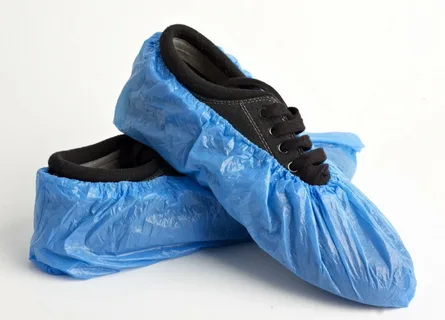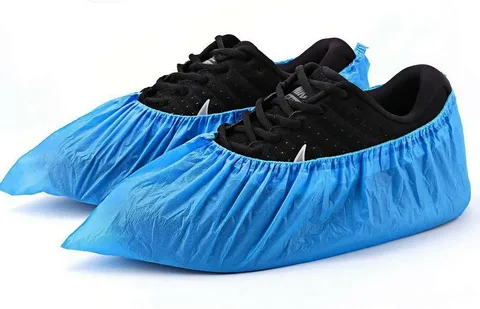Disposable shoe-covers are a simple yet effective way to maintain cleanliness in various environments. Whether in a healthcare setting, a laboratory, a cleanroom, or even at home, disposable shoe covers can help prevent the spread of dirt, germs, and contaminants. This comprehensive guide will explore the uses, features, advantages, and proper disposal of disposable shoe-covers.
Understanding the Basics of Disposable shoe-covers
At their core, disposable shoe-covers are fashioned from a non-woven, lightweight material crafted to envelop shoes securely. Their primary function is to act as a barrier against dirt, dust, and biological contaminants, ensuring a high level of hygiene in sensitive environments. Available in many sizes, these covers cater to a broad spectrum of footwear, from the petite to the more robust, ensuring a snug and comfortable fit for virtually any user.
Characteristically single-use, these covers are pivotal in curbing the transfer of potentially harmful materials from one area to another, thereby upholding the integrity of clean spaces. Their design is inherently user-friendly, allowing for swift and effortless application and removal, a feature that underscores their appeal in fast-paced settings. Emphasizing practicality, disposable shoe-covers are a testament to the seamless fusion of convenience and protection, designed to maintain pristine conditions in various settings.
 The Importance of Maintaining Clean Environments
The Importance of Maintaining Clean Environments
Maintaining pristine conditions cannot be overstated, mainly where sterility is crucial. Disposable shoe-covers are essential in this context, providing an additional barrier that reduces the ingress of pollutants and microorganisms. This precaution is vital in healthcare facilities, where preventing the transmission of infections is a primary concern. Similarly, in laboratories and food preparation areas, excluding external contaminants is necessary to ensure the integrity of experimental outcomes and food safety.
This protective measure extends beyond professional settings, providing peace of mind to homeowners who want to keep their living spaces free from outside dirt and potential allergens. It is a gesture of respect and hygiene, preventing damage to floors and carpets and preserving the aesthetic and sanitary condition of the interior environment. In educational institutions and industrial sites, where foot traffic significantly increases the likelihood of dirt accumulation, disposable shoe-covers are an effective solution for maintaining cleanliness standards.
In essence, adopting such protective gear demonstrates a collective commitment to hygiene, safeguarding the well-being of individuals and the purity of critical workspaces. It is a simple yet profound measure that reinforces the sanctity of clean environments, reducing the spread of undesirable elements across thresholds.
Diverse Applications of shoe covers disposable
The versatility of shoe covers disposable extends across many sectors, making them an indispensable accessory in various professional, medical, and personal settings. In the healthcare domain, they are a fundamental requirement, utilized extensively by medical personnel and visitors alike to prevent the spread of infections within hospitals and clinics. Laboratories benefit from the employment of shoe covers, ensuring that the controlled environments remain uncontaminated by external particles or substances that could skew research outcomes.
In real estate and construction, these covers protect flooring during open houses, renovations, and construction projects, safeguarding surfaces from scratches, dirt, and debris. Food processing plants adopt shoe covers to comply with stringent hygiene standards, reducing the risk of contaminating food products with pathogens or foreign matter introduced from outside. Similarly, in the electronics industry, where dust and static can cause significant damage, shoe covers help maintain a dust-free environment, which is crucial for the production and assembly of sensitive components.
Educational settings also find a place for disposable shoe-covers, particularly in science laboratories, where they contribute to maintaining a clean and safe learning environment. Cleanrooms, pivotal in manufacturing pharmaceuticals and precision electronics, mandate shoe covers to eliminate contaminants that could compromise product quality. The broad applicability of disposable shoe-covers underscores their role as a critical component in hygiene and safety protocols across various industries, highlighting their importance in maintaining standards and preventing contamination.
Key Features and Advantages of Using Disposable shoe-covers
Disposable shoe-covers boast many features that cater to the requirements of various sectors, underscoring their utility and effectiveness. These covers are inherently lightweight, promoting ease of movement and reducing fatigue in settings that demand prolonged use. The breathability of the material from which they are crafted ensures comfort, even in environments requiring extended wear periods. Notably, many variants come equipped with water-resistant properties, offering protection against spills and wet floors, thereby enhancing safety. Including non-slip soles is a critical advantage, as it mitigates the risk of accidents on slippery surfaces, a common hazard in places like hospitals and laboratories.
From a practical standpoint, these shoe covers are designed for ease of use, with elasticated openings that facilitate quick application and removal, an essential feature in fast-paced emergencies. Economically, the disposable nature of these covers means they are a cost-effective solution for maintaining hygiene standards without incurring the expense of laundering reusable options. This aspect particularly appeals to sectors where budget constraints are considered, but hygiene cannot be compromised. The availability of eco-friendly options addresses sustainability concerns, providing a pathway for organizations and individuals keen to reduce their environmental footprint while adhering to safety and cleanliness protocols.
How Disposable shoe-covers Promote Health and Safety?
In personal and public health, disposable shoe covers play a pivotal role. By acting as a barrier against the ingress of contaminants, these simple accessories significantly lower the risk associated with the transmission of germs and bacteria. This is particularly crucial in environments such as hospitals and laboratories, where sterility is paramount. Furthermore, incorporating non-slip soles on many disposable shoes covers enhances safety by reducing the likelihood of slips and falls on slick surfaces — a common concern in professional settings.
Additionally, by safeguarding floors and carpets from the damage caused by dirt and debris, these shoe covers contribute to a safer, cleaner environment, mitigating hazards and ensuring a higher standard of cleanliness. The practical benefits extend beyond the immediate vicinity, fostering a culture of safety and well-being that resonates through various sectors. As a tool for promoting health and safety, disposable shoe-covers underscore the importance of preventive measures in mitigating health risks and enhancing overall environmental hygiene.
Eco-friendly Options and Sustainability Concerns
In addressing the environmental implications of disposable shoe-covers, it’s heartening to observe a shift towards more sustainable practices within the industry. Innovations have created eco-friendly variants fabricated from materials that either biodegrade more swiftly or are produced using recycled content. These advancements represent a conscious effort to diminish the carbon footprint associated with the production and disposal of shoe covers. Significantly, such options do not compromise on the functionality or protective qualities that have made disposable shoe-covers indispensable across numerous settings.
Organizations and individuals increasingly recognize the value of selecting these greener alternatives, contributing to a broader movement towards sustainability. The availability of eco-conscious choices empowers users to align their health and safety protocols with environmental stewardship, marking a significant step forward in reconciling the necessity of disposable shoe-covers with the imperative of ecological responsibility.
Practical Tips for Selecting the Right Shoe Protection Covers
Choosing the appropriate shoe protection covers necessitates a thoughtful consideration of several pivotal factors to ensure they meet your specific requirements efficiently. Firstly, sizing plays a critical role; selecting a size that accommodates your footwear snugly yet comfortably is imperative, avoiding either an overly tight fit that could compromise the cover’s integrity or a loose fit that may pose a tripping hazard. Pay special attention to the material from which the shoe covers are constructed.
Options range from lightweight, breathable fabrics suitable for general use to more robust, water-resistant materials designed for environments where exposure to liquids is likely. Another aspect worth considering is additional features that may enhance safety and usability. For instance, shoe covers with non-slip soles prevent slips and falls on slick surfaces, making them an essential choice in clinical, laboratory, and industrial settings.
Furthermore, for those operating within sectors where environmental impact is a concern, opting for eco-friendly shoe covers made from biodegradable materials or incorporating recycled content can align with sustainability goals without sacrificing performance. In evaluating these criteria, it’s also beneficial to assess your environment’s specific conditions and challenges. This ensures that the shoe covers provide adequate protection and contribute to maintaining high standards of hygiene and safety in your space.
Correct Usage and Disposal of Disposable shoe-covers
Ensuring the effectiveness of disposable shoe-covers involves adhering to correct usage and disposal practices. To wear, one should gently stretch the cover over the shoe, ensuring the entire shoe is encased and the elasticated opening sits snugly above the shoe. This process helps in preventing the entry and spread of contaminants. Upon removal, it is essential to carefully peel the shoe cover away from the shoe, starting from the top edge and proceeding to invert it, thereby encapsulating any gathered contaminants. This method minimizes the risk of dispersing collected particles into the environment.
Immediate disposal into a designated waste receptacle is critical. It is advisable not to touch the outside of the shoe cover with bare hands to avoid transferring contaminants. If a hands-free bin is unavailable, wash your hands thoroughly or use hand sanitizer after disposing of the shoe cover. This routine should be strictly followed to maintain hygiene standards and to uphold the safety protocols in place. Remember, responsible disposal plays a pivotal role, as the correct usage of disposable shoe-covers prevents the spread of contaminants and ensures a clean and safe environment.
Conclusion
In summarizing our exploration of disposable shoe covers, their role in ensuring hygienic and safe environments across various settings is undeniable. From healthcare facilities to homes, their application serves as a testament to the universal need for maintaining cleanliness and preventing contamination. Embracing these protective accessories not only supports individual health but also promotes collective well-being. The move towards eco-friendly alternatives highlights a growing awareness and responsibility towards environmental sustainability, marrying the necessity of maintaining strict hygiene standards with the imperative of ecological conservation.
FAQs
Q: Is it possible to reuse disposable shoe covers for multiple occasions?
A: Disposable shoe covers are specifically designed for one-time use to avoid the risk of spreading contaminants between environments. Reusing them can compromise their effectiveness and is not recommended.
Q: Are there a variety of sizes available for disposable shoe-covers to fit different footwear?
A: Indeed, disposable shoe-covers are manufactured in a range of sizes to ensure a proper fit for diverse types of footwear. It’s essential to select a size that snugly fits your shoes to ensure maximum protection and to avoid any safety hazards, such as tripping.
Q: Can disposable shoe-covers be placed in recycle bins?
A: While certain disposable shoe-covers are crafted from materials that can be recycled, their exposure to potential contaminants typically makes them unsuitable for recycling. Consequently, they should be disposed of responsibly in the appropriate waste receptacles to prevent any risk of contamination. Always check the product specifications for any specific disposal instructions or consider eco-friendly options that are designed to have a lower environmental impact.
| Other Good Articles to Read |
| niche blogs connect |
| blogs 97 |
| Blog Stitution |
| blogs unplugged |
| blogs cotch rouge |
| blog signatr |
| blog sintonias |
| blog zilla |
| consumer forums |
| finance forums |
| g blogs |
| too blog |
| Related Business Listings |
| Contact Directory |
| Local Business Profiles |



